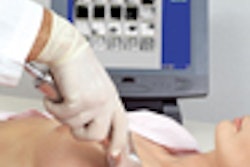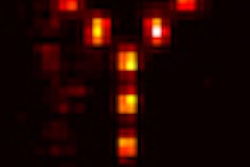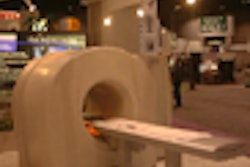SAN FRANCISCO - While a variety of radiotracers have been developed to study the metabolic processes of tumors, 18F fluorodeoxyglucose (FDG) PET is the current leader among physiologic imaging modalities. If performed carefully, FDG’s affinity for colorectal cancer makes the technique especially useful for assessing and treating the disease, according to Dr. Timothy Akhurst, a radiologist from Memorial Sloan-Kettering Cancer Center in New York City. Akhurst spoke at the Perspectives in Colorectal Cancer conference in San Francisco on September 8.
Each whole-body FDG PET scan takes about an hour, Akhurst said. The exam can yield excellent results if protocols are carefully followed and the modality’s limitations kept in mind, he said. The single most important factor is making sure patients have fasted at least six hours before the exam. This eliminates the possibility of excessive tracer uptake into the skeletal muscles, and to a lesser extent in the liver and adipose tissue, he said.
Akhurst showed a whole-body FDG PET image of a patient he said was "too nervous" to avoid eating before the exam. The resulting images showed muscular and hepatic FDG hypermetabolism that obscured widespread metastatic tumors.
"If you have an exam that looks like this, send the patient home for a day or two, because you won’t see the underlying tumors," Akhurst said. The lesions could be seen clearly, however, in follow-up images taken two days later, when fasting was maintained.
The images were a good reminder that "everything that uptakes glucose is not cancer," Akhurst said, an important limitation of metabolic imaging techniques. He produced an image of another nervous patient who’d done a lot of talking on the day of the exam; there was FDG uptake in the throat area resulting from inflammation.
Because tracer uptake into tissues is continuous, Akhurst said, images must always be taken at exactly the same time following injection of the radiotracer in order to assess treatment response accurately. The most commonly used measure of uptake is the standardized uptake value (SUV) formula, which normalizes uptake activity to the patient’s body weight and to the injected dose, but does not account for elapsed time between injection and imaging.
Once cancer has been detected, "treatment is a two-edged sword," he said. Chemotherapy can shrink tumor size and reduce hexokinase (HK) activity, for example, but it makes tumors more difficult to see with FDG PET, which relies on increased HK activity. As a result, "it’s important to have a baseline exam for every patient," Akhurst said.
He called the lack of baselines just one of several problems with current PET literature. In addition, he said, "much of it is retrospective, and there’s a huge referral bias."
It is clear, however, that PET outperforms CT when the two modalities are compared in ROC analysis, he said. In research at an Australian institution, Akhurst and colleagues found that CT and PET had sensitivity for cancer of 84% and 76%, respectively. Investigators at Sloan-Kettering found 100% sensitivity for primary T3 lesions of the rectum with FDG PET.
Just as important, the exam defines treatment for many patients. The addition of FDG PET data after conventional staging changes the course of treatment in about 30% of colorectal cancer patients at Sloan-Kettering, he said, noting that the technique can clearly indicate the need to change an unsuccessful treatment plan.
"Persistence of uptake in the face of chemotherapy is a very bad prognosis. You know you have to change the treatment," Akhurst said.
The value of sigmoidoscopic screening
In another presentation, Dr. Joseph Selby from Kaiser Permanente Medical Center in Oakland, CA, said four large controlled studies have concluded that screening of asymptomatic individuals with flexible sigmoidoscopy lowers both the mortality and incidence of colorectal cancer. The procedure is extremely safe; Doctors at Kaiser observed only six cases of serious complications in more than 118,000 patients screened over three years, Selby wrote in an abstract accompanying the presentation.
Fecal occult blood testing (FOBT) also has an important role in detecting adenomas or early cancer, particularly in proximal lesions beyond the reach of the sigmoidoscope, Selby wrote.
Meanwhile, a just-published study in the summer 2000 issue of the International Journal of Technology Assessment in Heath Care finds that flexible sigmoidoscopy performed every five years and an annual FOBT are the two most cost-effective strategies for screening colon cancer in asymptomatic adults aged 50-85 years.
Randomized trials have not yet been performed for colonoscopy, which studies show may find 50% more colorectal lesions than sigmoidoscopy in asymptomatic individuals. The exam requires sedation, however. Lieberman and colleagues (New England Journal of Medicine 343:169-174) endorsed the procedure, but found a serious complication rate of 3 per 1,000, more than 60 times that of sigmoidoscopy.
While the optimal combination of screening methods is not yet clear, increased screening overall may be the single most important cause of declining colon cancer incidence since 1985, Selby said.
"We have seen a rather remarkable decline of colorectal cancers within reach of a sigmoidoscope, a 30% decline in the incidence of distal colon cancer, and about a 25% decline in the incidence of rectal cancer" in the U.S., he said. At the same time, proximal colon cancer incidence remained steady.
National Institutes of Health officials think the good news is largely a result of former president Ronald Reagan’s 1982 colonoscopy, which fostered greater public awareness of colorectal disease.
"If they’re right, and we’ve only screened 40% of the population and we’ve accomplished this kind of reduction, think what we could do if we actually had a nationwide, thorough colorectal screening cancer program," Selby said.
By Eric Barnes
AuntMinnie.com staff writer
September 11, 2000
Related reading:
FDG-PET gains favor among referring doctors for cancer staging, treatment, June 7, 2000
Combined supine/prone imaging improves CT colonography results, September 6, 2000
Colonoscopy favored for colorectal cancer screening in asymptomatic adults, September 9, 2000
One-time colonoscopy is cost-effective in adults between 50 and 54 years old, August 2, 2000
Let AuntMinnie.com know what you think about this story.
Copyright © 2000 AuntMinnie.com



















